The Hawaii Ironman World Championship Is on Saturday. For the First Time, Only Women Will Compete.
- Oops!Something went wrong.Please try again later.
- Oops!Something went wrong.Please try again later.
This article originally appeared on Outside
On Saturday, over 2,000 world-class women will shoulder the monumental 140.6-mile challenge of the 2023 Hawaii Ironman World Championship. That's right, women. Just women.
For the first time ever, only women will compete in Kailua-Kona, Hawaii, as Ironman split the fields and moved the men's race to Nice, France, held four weeks ago on September 12.
We've come a long way since 1978, when 15 men (yes, just men) paid $3 for a spot on the start line of the first-ever Hawaii Ironman based on a bet over who was the better athlete--swimmers or runners. This year, the women's and men's races will dole out equal prize purses of $375,000 each, rolling down 15 places with $125,000 going to the winner.
Why is a women's-only Ironman World Championship significant? We'll tell you, below. Then sit back and watch some serious suffering on Ironman Live when the gun goes off at 6:25 A.M. Hawaii-Aleutian Time (12:25 P.M. ET) on Saturday, October 14. For a closer look at the course, athletes, and in-depth storytelling around the race, check out Triathlete's Kona Hub.
What is the Ironman World Championship?
What started off as a bragging rights contest between a handful of swimmers and runners, and a ridiculous challenge combining three endurance events into one, has grown into one of the most prestigious--and rigorous--athletic events in the world. Fifty-five pros and 2,000-plus amateur age-group athletes from 73 countries will race a 2.4-mile (3.8K) swim, 112-mile (180.2K) bike ride, and a 26.2-mile (42.2K) marathon run past the dramatic lava fields on the Big Island of Hawaii.
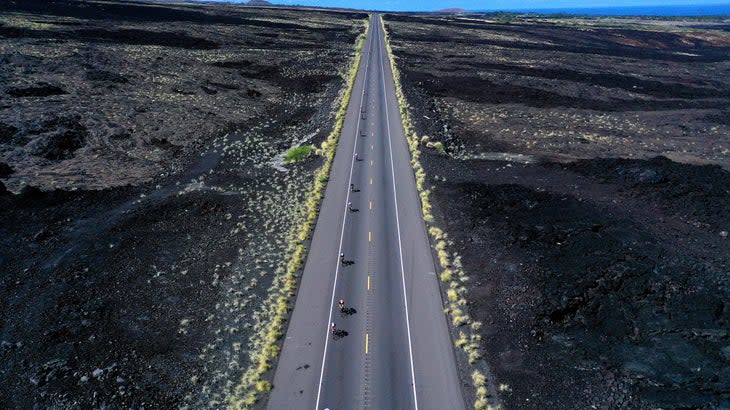
Why It's an Iconic Challenge
Racing the 140.6-mile Ironman presents a daunting challenge, requiring extreme versatility, discipline, and stamina just to get to the start--much less the finish. But to put it bluntly, this course and the conditions are hell.
In fact, the nearly impossible mystique of this race not only catapulted the popularity of Ironman, but also the sport of triathlon as a whole. The Ironman World Championship grew into a globally televised event on ABC, and the International Olympic Committee eventually added triathlon as a mainstay to the Summer Olympic Games in 2000.
An Endless 2.4-Mile Swim
The challenge starts with the swim, an out-and-back from the shallows of "Dig Me Beach" straight into the abyss beyond: Facing down 1.2 miles into the open ocean looks overwhelming, but then add in rolling seas, choppy, salty waves, and the churn of your competition. Top female pros complete the swim in just over 50 minutes, with the back of the age-group pack getting two hours and 20 minutes to climb out of the water before getting cut off. The swim is arguably the easiest part of the day, taking up less than 15 percent of the race time-wise.
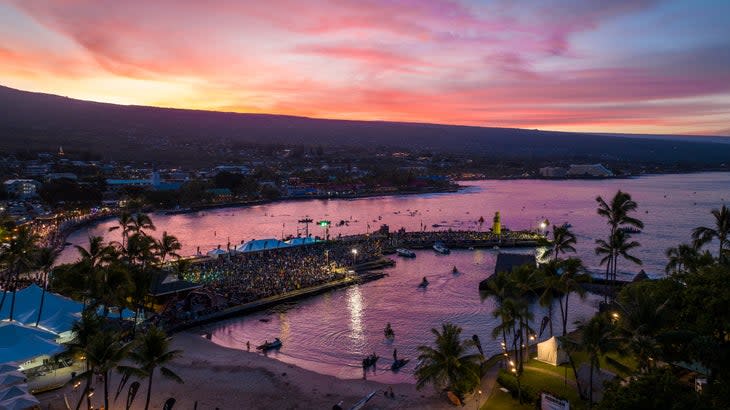
An Unforgiving 112-Mile Ride
After surviving the swim, competitors jump onto specialized triathlon bikes and pedal up and away from the ocean to the rolling climbs and straightaways of the Queen Ka'ahumanu Highway, renowned and reviled for its fierce crosswinds threatening to topple bikes over sideways and exposed lava fields that leave competitors with nowhere to hide from the sun. Imagine pedaling on Mars. Top riders complete the 112 miles in just over four-and-a-half hours for an average pace of 24-plus miles per hour. And if you don't finish the bike in 10 hours, you'll be pulled from the course.
A Soul-Sucking Marathon
Back in the transition zone, riders throw their bikes to handlers (one small luxury of long-course triathlon) and cinch up their running shoes before heading out onto the run course at the peak of the day's heat, where temperatures typically climb to 95 degrees Fahrenheit (35 degrees Celsius), with road temps escalating up to a shoe-melting 115 degrees Fahrenheit (46 degrees Celsius). Much of the run sends runners back out onto the Queen K, where they slog through the majority of the marathon on the shoulder of the highway, heat rising from the pavement and the unshaded sun glaring down from on high.
Top female pros will run under three hours, perhaps a full ten minutes faster than that, to average around 6:30 minutes per mile. For the women at the back of the race, they have 17 hours to cross the finish line, as the announcer blares into the PA system, "You are an Ironman."
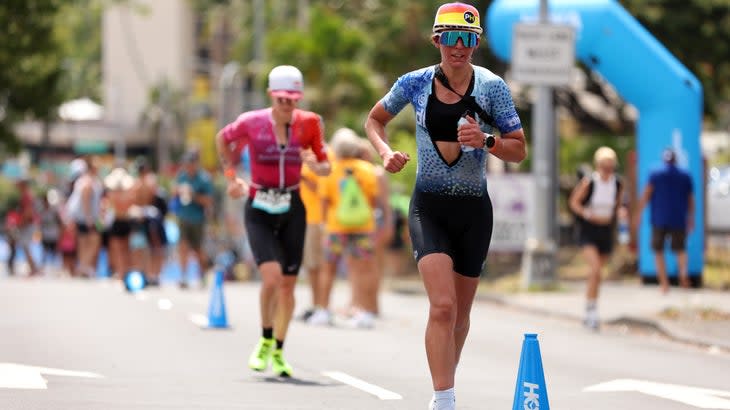
The Race Is Steeped in Lore
Kona doesn't just exude viscous crosswinds, endless straightaways, and suffocating humidity. Ghosts of its history haunt the course. It's where just 15 feet before the finish line in 1982, race leader and Kona rookie Julie Moss infamously collapsed from dehydration as ABC's cameras looked on. The 23-year-old exercise physiology student used her hands to crawl her way towards the finish--only to get passed by Kathleen McCartney with feet to go in one of the most monumental moments in televised sports history, forever altering the trajectory of Ironman as an internationally acclaimed event.
It's also where the "Queen of Kona" Paula Newby-Fraser of South Africa won an unprecedented eight world championships from 1989 to 1996, earning her a spot on Sports Illustrated’s top 60 athletes of the 20th century.
The Significance of a Historic Women's-Only Event
While no women competed during that inaugural race in 1978, women have played an instrumental role from the start. The notion of stringing a swim, bike, and run together was itself conceived by Judy Collins and her husband Jim, who cofounded the humble race that has escalated into one of the biggest endurance spectacles in the world.
Only one woman, Lyn Lemaire, completed the race the following year in 12:55:38, placing fifth overall against the men. Two women crossed the line in 1980, and this year more than 2,000 women from 73 countries will embark on their Kona journey. Splitting up the men's and women's races gave breathing room for Ironman to allow more athletes on the starting line. But examining the Ironman finish times of those qualified for the 2023 event reveals that the race remains as competitive as ever. In fact, the median finishing time of qualifiers this year is 11:53--15 minutes faster than last year's 12:08.
"It's as strong a field as perhaps has ever been assembled," Ironman CEO Andrew Messick says.
The Pro Field Is Wide Open
One of the deepest, most well-rounded fields ever will vie for the title at this historic women's-only event. It's anyone's race, and it could be one for the ages. Three previous champions will contend for another lei crown, including Marin County, California's Chelsea Sodaro who returns to defend her title. The 34-year-old mother broke onto the scene last year after switching athletic careers from running to triathlon in 2017.
A Kona rookie, Sodaro raced the 2022 championship as her second-ever Ironman. She returns with experience, but also the weight of success. Her 2022 win skyrocketed Sodaro into international fame, but sent her spirits plummeting. Her anxiety went through the roof, and she scratched from her first race of the season before dropping out of her first two races of 2023. Will she be able to harness her previous success, or will it hold her back?
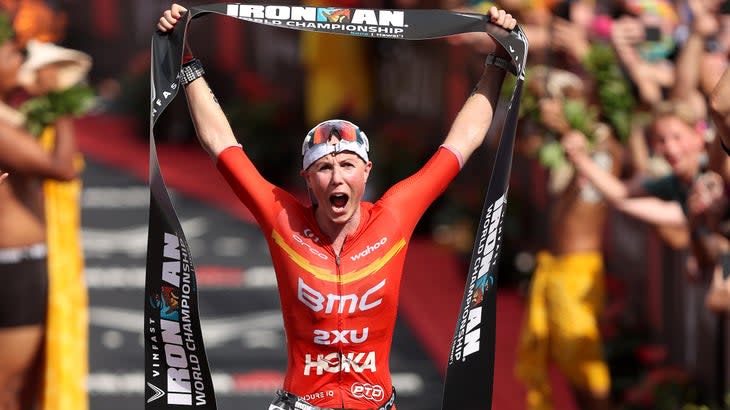
Sodaro will also face an esteemed list of previous winners, including six-time champion Daniela Ryf and 2019 winner Anne Haug, of Switzerland and Germany respectively. Four-time Kona bridesmaid Brit Lucy Charles-Barclay will be out for blood to finally land on that top wrung, although a metatarsal stress fracture this summer may dampen her plans.
Veterans will have to look out for dark horse Iron-rookie American Taylor Knibb, who toes the line as the youngest pro in the field at age 25. Already on Team USA for the 2024 Olympics in Paris, Knibb remains committed to short-course draft-legal triathlon racing. But she's quickly established herself as a top contender at longer distances, winning the 2022 and 2023 Ironman 70.3 world championships and the PTO U.S. Open in Milwaukee this summer, where she took home $100,000 and established herself as a dominant force at every leg of the race. Knibb may have never raced Kona, but she comes armed with the experience of her mother, who has raced here five times. Both Knibbs will compete on Saturday.
"It's incredibly special to race with my mom. She's very nervous for me," Knibb says. "She claims it's her last Ironman, and this is my first Ironman. So it's like a passing of the torch."
We May Witness the Fastest Hawaii Ironman Run Split Ever
In 2014, Mirinda Carfrae set the run course record of 2:50:26, en route to her second world championship title--a time that has stood for nine years through eons of shoe technology advancement. That time may pale in comparison to the women's marathon world record just set in September by Ethiopia's Tigist Assefa to 2:11:53. But holding 6:30 per minute miles while running through a convection oven after covering 114.4 miles by sea and two wheels--most of it crouched over on a time trial bike--is far more impressive than it may sound.
RELATED: The Science Says a Sub-Seven-Hour Ironman Is (Sort of) Possible
Thanks to the likes of running superstars Kat Matthews, Laura Phillip, Haug, and Sodaro, if the stars align that elusive 2:50 mark may finally be broken.
"I know a lot of runners here have the potential to run sub 2:50," Haug says. "But it all depends on how the race evolves. If you jump off the bike a little bit fresher than normal, it's possible."
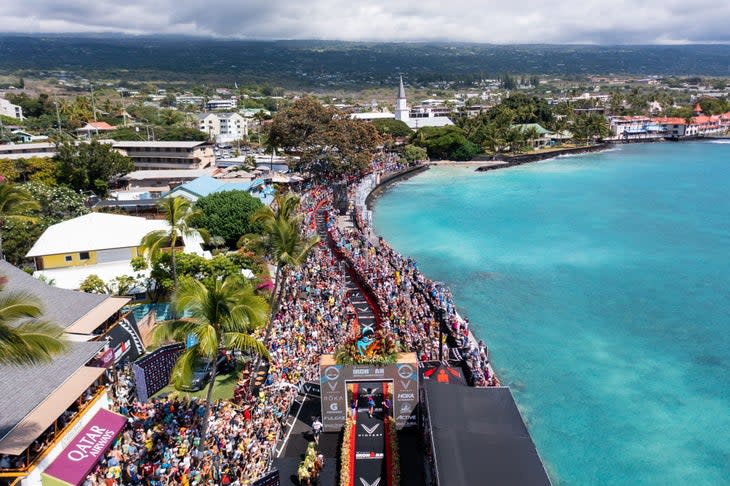
Everyone Here Has a Story
The professional race is just the tip of the sweltering iceberg here. The beauty of many endurance sports is that both pros and participants race alongside each other on the same course. Those include Sara Whittingham, a 2002 Ironman World Championship finisher from the U.S., a retired Lieutenant Colonel in the Air Force who served in Afghanistan and Korea. Three years ago at age 47, she was diagnosed with Parkinson's Disease. Motion is lotion as they say, and Whittingham channeled her energy into her joy for triathlons to maximize life and slow the progression of the disease.
"I have been racing since I was six years old. The Ironman World Championship will likely be the most meaningful finish line I will ever cross," Whittingham says. "When I was diagnosed with Parkinson's disease, I didn't see any more running in my future. I have always been one to dream big, and the finish line at Kona for me is as big as it gets."
Hailing from Kyiv, Ukraine, it took 35-year-old Juliya Azzopardi four days to drive 1,000 miles across the border, abide by a countryside curfew, go through two border controls, and catch two flights to the Big Island. That's an accomplishment in and of itself--much less the training required to qualify while in a war-torn country.
"Outdoor training could be the most challenging," Azzopardi says of getting here. "You might be riding your bike and then the air raid sirens go on. So then you have to get into the shelter, wherever you are. Find a way to hide, wait for it to finish. But it's not the physical part that's difficult. It's the mental part. If you're away from your family during an attack, you worry about them. The obstacles here are nothing compared to the training."
Even still, Azzopardi says the challenge of racing Kona is nothing compared to what those at home face on a daily basis. The bravery and strength of soldiers and civilians at home gives her strength and motivation.
"My goal is to show that life goes on," Azzopardi says. "For me, life is day-by-day. Living in a war zone, you never know when it's your last day. I want to represent resistance and the will to live, the will to fight. The right to live free and for peace. I think that's important now, not just in Ukraine unfortunately. In the race, I think about the soldiers who are suffering. And I understand that in an Ironman I am not suffering. I have no right to give up."
For exclusive access to all of our fitness, gear, adventure, and travel stories, plus discounts on trips, events, and gear, sign up for Outside+ today.

